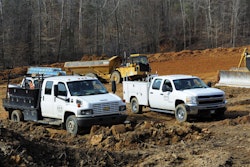ProPickup First Drive
2012 Venchurs CNG F-250 
Venchurs bi-fuel Super Duty conversion runs on both gasoline and CNG; alternative fuel choice makes sense in certain markets
By Steve Temple
Contractors and fleet managers feel pain at the pump more than most pickup owners, since one of their biggest overhead expenses is fuel. No surprise, then, that many are considering a variety of mileage extenders, using everything from computer tuning modules to fuel additives to alternative fuels.
We’ve been checking out one in particular, Venchurs Vehicle Systems (VVS) 2012 F-250 running a bi-fuel 6.2L.
The VVS conversion has the ability to operate on two separate fuel supplies, injecting either gasoline or compressed natural gas with the simple flip of a dash-mounted rocker as you drive. The transition between the two fuels is virtually seamless, with no obvious changes in performance.
In gasoline mode, the dash readout indicated 15 mpg on the highway at 65 mpg (Ford does not publish fuel economy ratings on this size of truck). The F-250’s onboard computer does not provide fuel consumption data when running in CNG mode.
 Filling the bi-fule F-250 isn’t much different than a standard gasoline version except it takes a couple minutes longer and uses a special connection. a
Filling the bi-fule F-250 isn’t much different than a standard gasoline version except it takes a couple minutes longer and uses a special connection. a
So we used the traditional method of counting miles and volume consumed to verify Venchurs’ mileage claims of 11/14 city/highway. Our numbers crunched out the same figures.
Even though the observed fuel economy is about a mile-per-gallon less with CNG (in an engine with a dual-fuel capability), it can dramatically reduce fuel costs, since the price of CNG runs $1.25 to $2 less on a per gasoline gallon equivalent (GGE) basis.
Another point in favor of a VVS conversion (available on the 6.2L F-350 as well) includes its designation as a “Ford Qualified Vehicle Modifier.” That means VVS conversion won’t void the factory warranty and can be rolled into Ford financing programs.
Moreover, the residual value of vehicles with CNG conversions tend to be much higher, possibly even more than upgrading to a diesel engine.
QUICK ROI
If CNG is readily available, then figuring the ROI is not that difficult.
How soon you could offset the $11,000 CNG option depends on several factors, such as the volume of fuel consumed, market fluctuations in fuel prices, and reduced maintenance expenses.
Considering just one scenario, using an annual mileage figure of 30,000 and approximate mpg figures noted above (14 vs 15 mpg), you’d consume 2,143 gallons running solely on CNG, compared with 2,000 gallons of gasoline.
As of this writing, the nationwide average price of CNG is $2.13/gal and $3.70/gal for regular unleaded. That pencils out to annual fuel expenditures of $4565 for CNG, and $7400 for gasoline at those prices.
Another variable to consider is that even though the fuel efficiency of bi-fuel is slightly less than with a conventional gasoline or diesel, the cost-per-mile is also lower. That’s because recommended maintenance intervals are increased, due in part to reduced emissions and particulate matter.
CNG DOWNSIDES
The downsides? Well, an obvious one is the size of the tank. On the F-250 tested, what looks to be a big diamond-plate toolbox is actually a federally-required safety cover housing a carbon-fiber 22-GGE CNG tank.
While other CNG fuel tank sizes and configurations are available, this one took up about a third of the cargo bed. With the tailgate lowered, you might be able to load some 4×8 sheets of plywood in there, but that would make sense for only occasional, short-haul trips.
Given the generous load capacity of a Super Duty, the increased weight of the extra tank and fuel is not all that noticeable, so there’s no obvious impact on handling or performance.
Then there’s filling time. CNG fueling requires a short learning curve, consisting of watching a brief safety video on locking the hose valve in place and getting a reusable PIN code. It also takes a couple minutes longer than pumping gasoline.
[youtube ukYJOakHGc4 nolink]
From our short seat time in the 2012 Venchurs Ford F-250, we’d say the VVS bi-fuel CNG conversion would be a viable choice for fleets and contractors who have ready access to CNG stations, don’t have to carry large loads in the bed, and spend a lot of time on the road overseeing far-flung jobsites.– Pro
CNG SOURCES
Venchurs Vehicle Systems: 517-263-8937; www.venchurscng.com
Clean Energy; www.cleanenergyfuels.com
BASIC SPECIFICATIONS
 Venchurs bi-fuel CNG conversion adds $11,000 to the price of a 6.2L 2012 F-250.
Venchurs bi-fuel CNG conversion adds $11,000 to the price of a 6.2L 2012 F-250.
- Make/Model: 2012 Ford F-350 Crew Cab 4×4
- Base MSRP: $29,065
- As-Tested MSRP: $40,065
- Engine: 385 HP, 6.2L 2-Valve SOHC.
- Torque: 405 lb-ft @4,500
- Axle Ratio: options range from 3.31 to 4.30
- MPG/EPA: 15 City/18 Hwy
- Observed MPG: 15mpg gasoline; 14 mpg CNG
- Fuel Capacity: 35 gals (plus 22 gallons of CNG)
- Tow Capacity (model tested): 12,500 lbs weight-distributing
- Payload capacity: 4,080 lbs
- Tires/wheels: size/type: LT245/75R17








